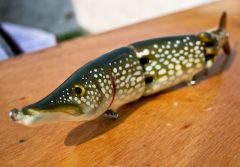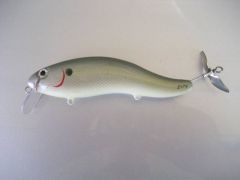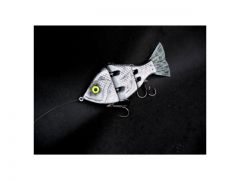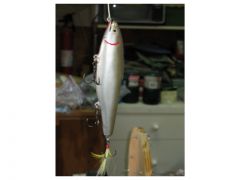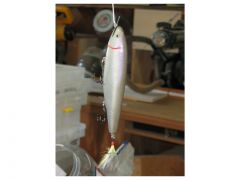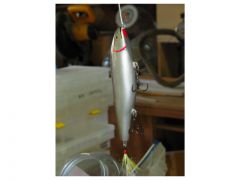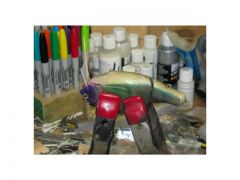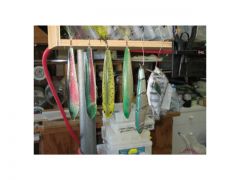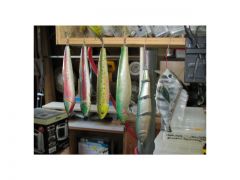-
Posts
14,726 -
Joined
-
Last visited
-
Days Won
364
Content Type
Profiles
Articles
TU Classifieds
Glossary
Website Links
Forums
Gallery
Store
Everything posted by mark poulson
-
Now that's funny!
-

Thinning Epoxy with Fingernail Polish Remover
mark poulson replied to .dsaavedra.'s topic in Hard Baits
Downriver, Why does D2T stay tacky if you mix in a thinner before the two part mix is thoroughly mixed? I'm guessing the thinner bonds to one part better than the other, and screws up the mix if they're not already mixed before it's added. But I'm certainly no chemist, or epoxy solvent expert, although I have tested my share of alcohol "solvents". -
Pete, If I had made that lure, I'd take off the hooks and put it next to one of my buddies while he's sleeping on our next two day salt trip. This guy got bitten pretty good by a "dead" barricuda on our last trip. He'd jump out of his bunk when he woke up next to that! That thing looks real enough to bite you!
-
Here's a 7" glider of mine that I just repainted. You can see the hook locations from the picture. Don't tell Bruce I finally figured out how to post pics. He's already far enough around the bend.
-
-
Bob's right about having to actually weight your lure until it sits the way you want it to, and the way it fishes best. I've found, as a general rule, that the lighter, hollow plastic lures hang tail down, in large part because they are tail weighted to make them castable, and it's not that hard to get a hollow plastic bait up and walking on the surface, since they're light. Wooden baits, on the other hand, are heavier to start with, and need less weight as tail ballast to get them to cast well. And a wood bait that hangs down into the water at a 45 degree angle, like a spook does, is a bear to get up on the top and walking. But they do need tail weighting. Just not as much as a light plastic lure. So I've found weighting wooden baits a little more finicky, but they glide much better. Once I've shaped my lure, and installed the weighted hook hangers (including the tail hook hanger) and line tie, I seal the bait and float test it. I want the lure to sit almost horizontal, but with the tail slightly down. I use my finger as a balance point, and I want the lure's center of gravity to be slightly back of the actual center of the lure. All most a 3/2 ratio in length, so, if the lure is five inches long, the center of gravity will be 3 inches back from the nose. It's approximate, depending on how buoyant the wood is, and how much wood there is left when you're done shaping. That's where Bob's advice about playing with the weighting comes in. I put on the split rings and trebles, and then add ballast weight, in the form of lead sinkers hung from the trebles, or taped to the belly, until I get the lure to sit down enough, and at the right angle. Remember that the paint and epoxy will add a little weight, 2 to 3 grams, but it will be evenly distributed, so it won't change the overall attitude of the bait (angle it sits in the water). But it will make it sit a little deeper, so allow for that. The first 1/3 to 1/2 of the lure's back should be just above the surface, but it should still sit almost horizontal. This keeps the lure up high enough to make walking it easier. I've made some which hang down too much, and they are a nightmare to work for any length of time. I would say go into it knowing you won't get it right the first time. If you do, you can buy my lottery tickets for me. But, just because it isn't right the first time doesn't mean it's ruined. There are a lot of things you can do to adjust it. If it's too heavy, you can drill out some of the ballast lead, as long as you do it evenly, so it doesn't change the way the lure sits. If it's too light, you can increase the size of the hooks and split rings, and add another coat of epoxy. I find the key is to get it as close as I can in my test bucket, by pinching on weights, and erring toward a little too light, if anything. I just try to get it to sit right, and then place the ballast as close to the hook locations as I can to keep that attitude. Sorry to be so long winded. I think most of what I've just said will plug in as common sense once you've thought about it. If it were rocket science, I wouldn't be able to do it.
-
Thin with Windex.
-
I would buy a clear Spook and check out how it's weighted.
-

Thinning Epoxy with Fingernail Polish Remover
mark poulson replied to .dsaavedra.'s topic in Hard Baits
When I first started using Etex, I called their help number from their website, and spoke with a woman who was very helpful. I subsequent emails she said the best thing to thin Etex with was denatured alcohol. I don't thin it myself, but that's what she said. I've learned that, in mixing D2T, it's important to mix it thoroughly without any thinning first, let it sit for a minute to make sure all the separate chemicals have had a chance to really interact, and then coat with it. Any alcohol contamination, like on a mixing stick that's been soaking in alcohol, seems to mess up the mix. Etex is a little more forgiving. I haven't found the need to slow down the D2T. I just mix enough to do one or two lures at a time. Mixing more isn't that big a deal, and it mixes up and goes on so fast it doesn't take that much extra time. And I only use D2T for plastic cranks, or to coat the insides of my swimbait joints, or for gluing in hardware and lips, so I don't ever need a big batch. For the big faces on my wooden swimbaits and gliders, I use Etex. -
Don't let the wall fool you. A lot of the really bad ones got cut up and refashioned into something that did work. I have three jointed lures in my tackle box that I know are going to fail, since the other three I did the same way at the same time have already failed. I'm just waiting until the finish cracks, and then I'm going to have to strip those down and start over with them, too. I've been very fortunate. After I made my first pupfish replacement attempt, and painted it with rattle cans, I found this site, and it has really shortened my learning curve. I still make my share of mistakes, but less now than before, and, thanks to this site, at least I know how to fix those mistakes. The hardest thing for me is admitting a lure needs to be redone. I just keep thinking, "If I just tweak it here, or add some crazy glue there, I can get by with it". But I've learned that I won't throw a lure enough if I think there's something wrong with it, even if I might get bit. Anyway, just remember, "Lawyers send their mistakes to jail, doctors bury theirs, but the rest of us have to live with ours, even the ones we elect".
-
Dieter, This is a lousy picture. I had already tied it on to my rod, so I just used the black boat cover for a background, and it doesn't photograph well. In real life, it does look silver, with black scale lines. Rookie, It swims like a fiend, with a flag waving action, even at low speeds. And when I burn it, it goes nuts. I couldn't be happier about the action. I made the tail out of a clear margarine tub top. It's a tough, flexible plastic, that I sand to add grain in the direction I want, like rays, and then color with sharpies. Dean, Thanks. The best part is I already know it catches fish. A-Mac, I wanted something that would look like a crappie or baby bass in color pattern, and in body shape, more or less. I don't think the bass have degrees in prey identification. If it swims, so it looks alive, and is reasonably colored, so it resembles something they eat, it works. And I want something that will attract their attention, like the big chartruese eyes with the black outline, an idea I got on this forum.
-
Chris, What kind of topwater? That makes a difference in where you put the weights. For me, walking baits and poppers, want to hang tail down, or at least tail lower than the head. Big gliders also want the balance point just rear of the middle of the bait, but want to sit horizontal in the water, with 1/3 to 1/2 of the front part out of the water. I find some lead in the tail helps with the walking gliding action of the bigger baits. Frogs I want to float with their eyes above the water, but that's tough to get just right. But it all starts with what kind of topwater. You can play around with your lures without ruining them, as long as they're sealed so they don't absorb water. You can get so suspend dots and strips and try that in different places, so you can see how it affects the action. You can use fly tying lead wire and wrap it around your hook shanks. You could make a prototype/copy and actually drill for weights and stick them in temporarily, until you get the action you want. Different shapes need different weighting, so you're probably going to have to fool around a while until you come up with the right weighting for your lures. Good luck.
-
Good looking wheel. Good solution. I like your metal work. Good looking lure on the wheel. You can suspend assembled jointed lures, or one piece lures, by putting opposing screw eyes or cup hooks on the faces of the discs, and using big paper clips to hand the lures from the line tie and hook hangers.
-
Could you coat the eyes in a clear first that is immune to acetone? Maybe a drop of D2T epoxy?
-
First of all, thank you to Bruce, or whoever it was who enlarged my pictures. I'm totally lost when it comes to how to do it. Each time I post in the gallery I have to relearn how to do that. And that's "easy". You guys are too kind. The truth is some of them do work, but, as Bob said, I have no confidence in them, so I don't throw them. I actually did reshape and repaint quite a few already, and made them work better or improved the paint job. I hate to see all that material just hanging there. My biggest disappointments were the tilapia, the jointed silver/aqua trout, and the jointed bluegill, which is now receiving a lip transplant. I made the joints too tight on the big trout, and it doesn't swim. I'll probably pull the pins and open the joints up eventually, and then do a different paint scheme. And the bluegill has sort of a lame, wandering, rolling action, so I'm hoping a wake bill with at least get it to swim a bit more. I think I made it too fat and tall. I had to add so much ballast to get it to float upright that it is a floating rock right now. But I did learn from them, so they weren't failures, they were just lures that didn't work. I mostly keep them up there to remind me to test well before I paint.
-
DSV, Your lure is hand made, original, and unique, and that makes it worth a lot more than a plastic production lure all day long. Split the difference between your $20, and my $75, and ask $55. If you don't ask, you'll never know. You already know you have a market at $20. Find out just how much your time and effort are really worth. I, for one, would feel like I was taking advantage of you if I let you sell me one of those lure for only $20. It's worth a lot more than that, period. If you don't believe me, do a site search for the Rookie, and pm him and ask him. He know the value of lures. He makes and sells them, and he's honest. Not pretty, but honest.
-
I posted these in the gallery. They are some of my not so great attempts. I don't know how to make the larger. Sorry.
-
At the risk of alienating everyone on this site, you're not charging enough. Those lures are worth at least twice what you're asking, if not more, and shipping is going to set you back at least another $5. And you had to pay for the wood, hardware, paint, and epoxy. Ask for what they're really worth, and what you'd like to get for them. The worst that will happen is you may have to lower your price, but you'll never know what they're worth unless you ask a good price for them. Your time and effort is worth more than $20 for those lures. That bluegill is a $75 lure. Go online and check out some of the lures that are getting big bucks on Ebay. Yours shine compared to a lot of them. Remember, if you sell yourself short, there's always someone to meet your price.
-
Sometimes that happens to me if I don't let the epoxy sit for a minute to let the big bubbles rise and burst. Also, if I add alcohol to thin it, I need to wait, too. Last possibility might be alcohol in the brush that reintroduces some bubbles as you brush. It may have something to do with the photo finish process, but I doubt it. Mostly it's because epoxy doesn't like us, and just does stuff like that to piss us off!
-
I repainted one of the original bruisers I made. My partner named the series the Bruisers, because the originals looked like stocked trout that had been bruised and beat up in the stock truck. I did this one in Auto Aire aluminum, with a dark moss green back and shoulders, and Wildlife iridescent violet scale over that. Then I sprayed it with silver Krylon glitter, a coat of clear gloss with UV protection, and two coats of Etex. I'm anxious to see if the UV coat under the Etex helps to keep the lure from yellowing. If it doesn't, I'll try it over the Etex, but I don't think it will hold up.
-
I repainted one of the original bruisers I made. My partner named the series the Bruisers, because the originals looked like stocked trout that had been bruised and beat up in the stock truck. I did this one in Auto Aire aluminum, with a dark moss green back and shoulders, and Wildlife iridescent violet scale over that. Then I sprayed it with silver Krylon glitter, a coat of clear gloss with UV protection, and two coats of Etex. I'm anxious to see if the UV coat under the Etex helps to keep the lure from yellowing. If it doesn't, I'll try it over the Etex, but I don't think it will hold up.
-
I repainted one of the original bruisers I made. My partner named the series the Bruisers, because the originals looked like stocked trout that had been bruised and beat up in the stock truck. I did this one in Auto Aire aluminum, with a dark moss green back and shoulders, and Wildlife iridescent violet scale over that. Then I sprayed it with silver Krylon glitter, a coat of clear gloss with UV protection, and two coats of Etex. I'm anxious to see if the UV coat under the Etex helps to keep the lure from yellowing. If it doesn't, I'll try it over the Etex, but I don't think it will hold up.
-
These are some of my early attempts, some of which didn't work, some of which did, but whose paint jobs failed. The lure on it's back is a jointed bluegill that I'm trying to save by giving it a lip. Fingers crossed. The big tilapia lure with the fin was my first lipped bait attempt. Wallowed like a "set down hog". Plus it weighed six ounces, so it was brutal to cast, so it's "retired". The big pupfish is the one I broke, which started me on this lure-making insanity. I have several marginal lures in my boxes on the boat. Can't seem to give up on them. Dumb.
-
These are some of my early attempts, some of which didn't work, some of which did, but whose paint jobs failed. The lure on it's back is a jointed bluegill that I'm trying to save by giving it a lip. Fingers crossed. The big tilapia lure with the fin was my first lipped bait attempt. Wallowed like a "set down hog". Plus it weighed six ounces, so it was brutal to cast, so it's "retired". The big pupfish is the one I broke, which started me on this lure-making insanity. I have several marginal lures in my boxes on the boat. Can't seem to give up on them. Dumb.
-
These are some of my early attempts, some of which didn't work, some of which did, but whose paint jobs failed. The lure on it's back is a jointed bluegill that I'm trying to save by giving it a lip. Fingers crossed. The big tilapia lure with the fin was my first lipped bait attempt. Wallowed like a "set down hog". Plus it weighed six ounces, so it was brutal to cast, so it's "retired". The big pupfish is the one I broke, which started me on this lure-making insanity. I have several marginal lures in my boxes on the boat. Can't seem to give up on them. Dumb.



